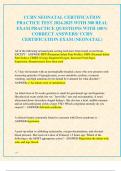CCRN NEONATAL CERTIFICATION
PRACTICE TEST 2024.2025 WITH 300 REAL
EXAM PRACTICE QUESTIONS WITH 100%
CORRECT ANSWERS/ CCRN
CERTIFICATION EXAM (NEONATAL)
All of the following neonatal pain scoring tools have been tested on newborns
EXCEPT - ANSWER-PIPP (Premature Infant Pain Profile), NIPS (Neonatal Infant
Pain Scales), CRIES (Crying, Required Oxygen, Increased Vital Signs,
Expression, Sleeplessness) have been used
A 7-day-old neonate with an unremarkable hospital course who now presents with
increasing episodes of hypoglycemia, severe metabolic acidosis, recurrent
vomiting, and high ammonia levels should be evaluated for what disorder? -
ANSWER-✓ An inborn error of metabolism
An infant born at 36 weeks gestation is small for gestational age and hypotonic.
Her physical exam yields low set, "fawn-like" ears and micrognathia. A renal
ultrasound shows horseshoe shaped kidneys. She also has a loud, audible murmur
and an echocardiogram yields a large VSD. Which congenital anomaly do you
suspect? - ANSWER-Edwards syndrome
A clinical feature commonly found in a neonate with Down syndrome is -
ANSWER-hypotonia.
A post-op infant is exhibiting tachycardia, oxygen desaturations, and elevated
blood pressure. She received a dose of Fentanyl 1.5 hours ago. Which of the
following is the MOST appropriate action? - ANSWER-Reposition the infant with
arms and legs flexed.
pg. 1
,If the neonate is symptomatic with a plasma glucose value of less than 40mg/dl
(2.2 mmol/L) and is refusing or NOT tolerating feedings, the nurse should request
orders for the following interventions: - ANSWER-an intravenous bolus of 2 ml/kg
D10W and an intravenous D10W infusion initiated at 80 ml/kg/day.
A neonate at 10 hours of age is found to be cyanotic and without respiratory
distress symptoms. The EKG and chest x-ray are normal. The administration of
oxygen is not relieving the cyanosis. The healthcare provider should have a high
index of suspicion for which of the following defects? - ANSWER-Transposition
of the great vessels
What is the timeframe for early hyponatremia in the neonate? - ANSWER-1-2
days
When caring for a newborn on an insulin infusion, the glucose levels should be
monitored how often during the initial titration of the drip? - ANSWER-Every 15
minutes
Which of the following does NOT cross the placenta from the mother to the fetus?
- ANSWER-Insulin
Which of the following parties is MOST essential to the feeding experience of the
NICU infant? - ANSWER-Parent/family member
Which substrate is the major source of fuel to the brain? - ANSWER-Glucose
Who should dictate the feeding experience in the NICU? - ANSWER-NICU infant
pg. 2
,A 38-week gestation neonate presents to the NICU with respiratory distress
symptoms and anuria. On physical examination, she is found to have hypertension,
bilateral flank masses, and hypoplastic lungs. The best diagnosis for this
presentation is - ANSWER-polycystic kidney disease.
A newborn's maternal history includes oligohydramnios sequence. What might be
an expected finding on physical exam? - ANSWER-Compressed facial features
potter's sequence;bilateral renal agenesis, atresia of the ureter or urethra, polycystic
or multicystic kidney disease, renal hypoplasia, amniotic rupture, maternal
hypertension/pre-e
A priority of management for the neonate diagnosed with polycystic kidney
disease is - ANSWER-treatment of systemic hypertension. monitoring and
treatment of hypertension, nephrectomy sometimes indicated, peritoneal dialysis
Clinical manifestations of hypothyroidism include - ANSWER-decreasing body
growth and enlarged tongue.
Clinical presentation of acute renal failure includes all of the following EXCEPT -
ANSWER-serum creatinine <1.5 mg/dl (132.6 μmol/L). oliguria, normal urine
output, elevated creat, polyuria, hematuria, proteinuria, fluid overload,
dehydration, vomiting, poor eating, elevated medication levels
Clinical presentation of renal vein thrombosis includes - ANSWER-hematuria and
anemia. hematuria, flank mass, thrombocytopenia, transient hypertension, urine
output of <1 ml/kg/hr, anemia
During pregnancy, maternal ingestion of goitrogenic substances such as iodide or
lithium may lead to which of the following endocrine conditions? - ANSWER-
Transient congenital hypothyroidism
pg. 3
, The full newborn cardiovascular assessment includes auscultation, inspection, and
palpation. The point of maximum impulse is usually palpable and can be
auscultated in the - ANSWER-third to fourth intercostal space and left of the
midclavicular line.
The neonate born to a mother with uncontrolled diabetes mellitus should be
evaluated for - ANSWER-congenital malformations.
You are the nurse caring for a 38 weeks gestation, female infant, who was born one
hour ago in the parking lot of the emergency room. On admission to the nursery,
the neonate's rectal temperature was 95ºF (35ºC). You recognize that cold stress
may predispose the infant to - ANSWER-increased oxygen consumption and
hypoxia.
A full term neonate who presents at six hours of age with increasingly labile
oxygenation that appears disproportionate to the pulmonary disease should be
evaluated for - ANSWER-pulmonary hypertension of the newborn.
A deformation is a(n) - ANSWER-abnormality caused by unusual mechanical
forces on normal tissue.
A low birth weight infant's temperature increases during skin-to-skin care. This is
an example of heat transfer by - ANSWER-conduction.
At the onset of labor the release of catecholamines stimulates - ANSWER-
increased absorption of lung fluid.
An edematous, bruised lesion on the right anterior scalp where the vacuum was
applied. This lesion has clearly demarcated edges, is firm to touch, and does not
cross the suture line. This is best described as a - ANSWER-cephalohematoma.
pg. 4




